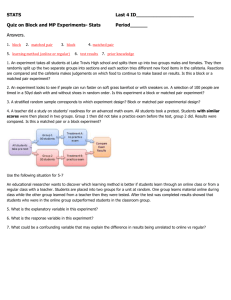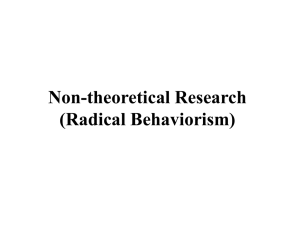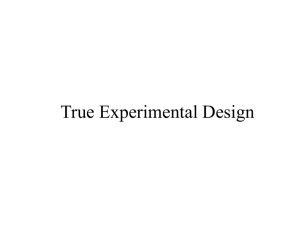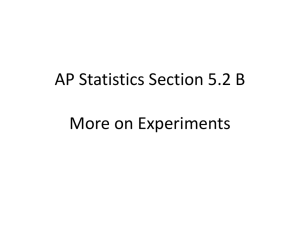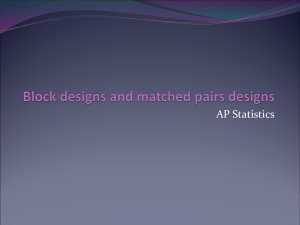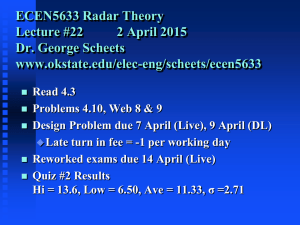Chapter 9
advertisement
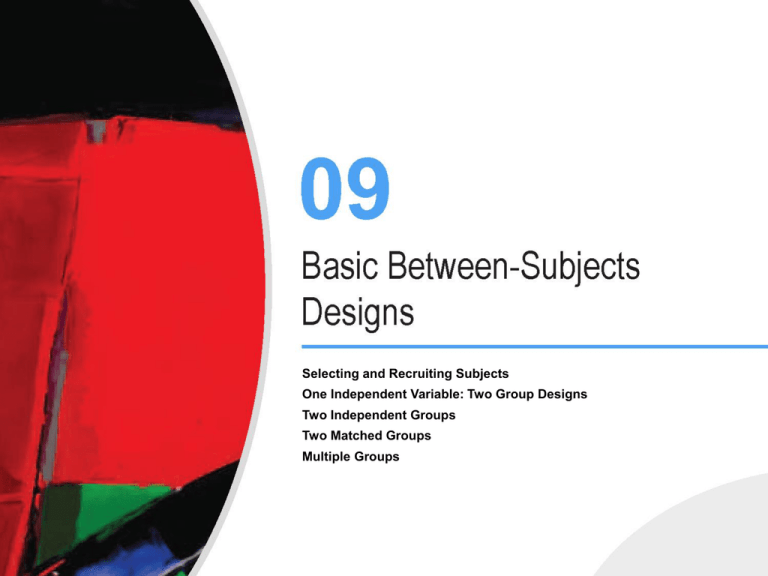
Selecting and Recruiting Subjects One Independent Variable: Two Group Designs Two Independent Groups Two Matched Groups Multiple Groups What is the purpose of an experimental design? The design of an experiment details an experimenter’s plan for testing a hypothesis. The design is the experiment’s structure or floor plan—not the experiment’s specific content. We can use the same design to investigate different hypotheses. Introduction What determines an experimental design? The experimental design is largely determined by the experimental hypothesis. A researcher mainly selects an experimental design on the basis of three factors: 1. the number of independent variables in the hypothesis Introduction What determines an experimental design? 2. the number of treatment conditions needed to fairly test the hypothesis 3. whether the same subjects are used in each of the treatment conditions Introduction What constitutes a between-subjects design? In a between-subjects design, a subject participates in only one condition of the experiment. Introduction What determines whether we can generalize our findings? The representativeness of our sample determines whether we can generalize our results to the entire population from which the sample was drawn. Random sampling increases an experiment’s external validity. Selecting and Recruiting Subjects What is the minimum number of subjects for each group? You should have at 10-20 subjects in each treatment condition to detect a strong treatment effect. Fewer subjects in each condition risks not detecting the effect of the IV on the DV. Selecting and Recruiting Subjects What is effect size and why is it important? Effect size is a statistical estimate of the size or magnitude of a treatment effect. The larger the effect size, the stronger the relationship between the independent and dependent variables, and the fewer subjects needed to detect a treatment effect. Selecting and Recruiting Subjects Explain the relationship between effect size and sample size. Effect size determines the number of subjects required to detect a treatment effect. Researchers determine the number of subjects required for an expected effect size using power charts or programs that incorporate these charts. Selecting and Recruiting Subjects What is a two group design? A two group design involves the creation of two separate groups of subjects. Two versions of the two group design are the two independent groups design and two matched groups design. One Independent Variable: Two Group Designs What is a two independent groups design? A design where there is one IV with two levels and subjects are randomly assigned to one of the two conditions. This design includes the Experimental GroupControl Group design and Two-Experimental Groups design. Two Independent Groups Why do researchers use random assignment? Random assignment involves assigning subjects to conditions so that each subject has an equal chance of participating in each condition. We use random assignment to equally distribute subject variables between the treatment groups to prevent them from confounding an experiment. Two Independent Groups How do experimental and control conditions differ? The experimental condition presents a value of the independent variable. The control condition presents a zero level of the independent variable. Two Independent Groups Explain an experimental group-control group design. This is a two independent groups design. The experimental group receives a level of the IV and the control group receives the same procedures, but receives no treatment. Two Independent Groups Describe a two experimental groups design. In a two experimental groups design, we assign subjects to one of two levels of the independent variable. This design is appropriate if there is one independent variable with two levels and if we can assume that randomization will control extraneous variables. Two Independent Groups What limits the effectiveness of randomly assigning subjects to different conditions? Random assignment works poorly with 5-10 subjects per condition. Since people often differ on many subject variables that could potentially confound your experiment, random assignment may not control all of them. Two Independent Groups When would you use a two independent groups design? This design is appropriate if there is one independent variable with two levels and if we can assume that randomization will control extraneous variables. Two Independent Groups What is a two matched groups design? In a two matched groups design, we: 1. match participants on a subject variable correlated with the DV, and 2. randomly assign them to one of two treatment conditions Two Matched Groups What is the purpose of matching? Matching is used to create groups that are equivalent on potentially confounding subject variables. Successful matching prevents selection threat from undermining internal validity. Two Matched Groups What must we measure to form matched groups? We need to measure an extraneous variable, strongly correlated with the dependent variable, that could confound our results if not controlled. Two Matched Groups How would you match on IQ using precision matching? Form pairs of identical IQ scores (120 with 120). Randomly assign members of each pair to one of two treatment conditions. Two Matched Groups How would you match on IQ using range matching? Form pairs of scores that fall within a specified range like 5 points (115 with 120, 135 with 140). Randomly assign members of each pair to one of two treatment conditions. Two Matched Groups How would you match on IQ using rank-ordered matching? Rank all IQ scores from highest to lowest. Form pairs of scores that fall in adjacent ranks (1st score with 2nd score, 3rd with 4th). Randomly assign members of each pair to one of two treatment groups. Two Matched Groups When should you use a two matched groups design? You should use a two matched groups design when there are two levels of an independent variable and there is an extraneous variable we can measure that could affect the dependent variable. Two Matched Groups Differentiate between multiple groups and multiple independent groups designs. A multiple groups design is a between-subjects design with more than two levels of an independent variable. In a multiple independent groups design, we randomly assign subjects to one of the treatment conditions. Multiple Groups What is block randomization and what does it guarantee? Block randomization is a process for randomly assigning equal numbers of subjects to conditions. The experimenter creates random sequences of each experimental condition and subjects are randomly assigned to fill each treatment block. Multiple Groups How should a researcher choose the number of treatments? The hypothesis, prior research, pilot study results, and practical limits can all help determine the number of treatments. A researcher needs to answer the question: “What will I gain by adding these extra conditions to the experiment?” Multiple Groups What are the practical limitations on the number of treatments? Practical limitations include: available subjects time expense Multiple Groups What is a pilot study and how can it aid an experiment? A pilot study is a trial run of the experiment that uses a few subjects. A pilot study can help the experimenter refine the procedure or determine whether the experiment is promising. Multiple Groups What is a pilot study and how can it aid an experiment? A pilot study can reveal whether: you have allocated sufficient time your instructions are clear your deception worked you need additional treatment conditions Multiple Groups
